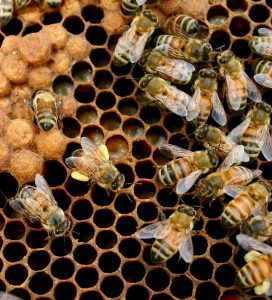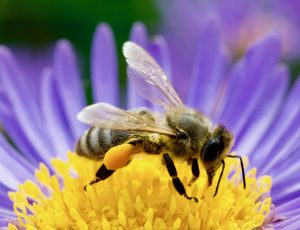
foraging bee
There are a million facts (an exaggerated guess) about honey bees available on the Internet. Why the need for another list? I came to realize that my knowledge was somewhat lacking after helping an apiarist with the hives on our farm and completing a few courses on beekeeping. As my experience increased, so did my respect and admiration for the busy little bees. The harmony and organized perfection contained in a honey bee colony earn them the right to have a million and seven facts. And with that thought, here’s my short list:
Majority of bees are sexually underdeveloped females.
Worker bees are non-fertile females representing 98% percent of the colony. They are responsible for all the work in the hive except for producing eggs. When the colony has no queen, a few worker bees can lay eggs, but they will only create drones. If the queen is killed, removed or has left, workers will feed extra royal jelly to female larvae (laid from the missing queen) to produce a new queen. Yes, it only takes a few extra days of royal jelly to become regal. There’s only one queen bee (unless a mutiny is occurring) and the remaining 2% of the hive are male drones.

queen bee and her court
The queen bee has a royal court.
The nurse bees (royal court or attendants) surround the queen at all times and will make most, if not all, decisions for her. The queen has one task, and that is to produce more bees. On average, she will lay about 1,500 eggs per day and up to 250,000 per year. A healthy queen can live up to 5 years. Dependent on her lifespan, she could produce more than a million eggs. Additionally, the queen secretes a pheromone substance that is spread throughout the hive. This substance helps to build a cohesive workforce within the colony.
Worker bees make the decisions for the colony.
A colony can have 50,000 to 60,000 worker bees, and they’re responsible for all colony related decisions and work. From day one they have a job. As they age, their roles change and ultimately they will perform all tasks. During the first few days of their lives, they focus on cleaning cells and keeping the brood warm. Eventually, they will take on the responsibilities of feeding larvae, then producing wax and building combs. As they reach their 18th day of life, they start guarding the hive. When they hit the big 21, they get to forage for food and pollinate flowers.
Drones only purpose is to mate.
Drones are male bees with one primary job, and that is to mate with a queen bee from another colony. They die after mating, and unfortunately for many drones, they will never get a chance to date a queen. When fall comes, and the nectar becomes scarce, the worker bees will force them out to starve. If the colony has no queen, they might be allowed to stay. As harsh as it sounds, this process of house cleaning prolongs the colony’s food supply for winter. Many beekeepers believe that they serve another purpose not yet identified. As for now, drones appear not to be needed during winter and they apparently consume too much food
 Bees dance to communicate locations of food source.
Bees dance to communicate locations of food source.
In 1973 the Austrian scientist Karl von Frisch was awarded a Nobel Prize for decoding the language of the honey bee’s waggle dance. He found that bees communicate an invisible map that identifies where food sources reside. By waggling (vibrating) their abdomens and releasing a scent, they share location and resource amount. The dance and information shared, saves time for a foraging bee mindlessly looking for nectar.
The vibrating waggle dance is a figure eight pattern. The vibration intensity and the amount of figure 8’s performed informs others about the distance and level of excitement. An excited bee can only mean a lot of food. The dancer’s direction and pattern convey the relation to the sun that the treasure resides.
 Bees cannot see red.
Bees cannot see red.
They can see yellow, green, purple, blue and a color called bee’s purple which is a yellow and ultra-violet combination that humans cannot see. Their ability to see ultra-violet light helps guide them to finding nectar. Many flowers have ultra-violet ‘bulls-eye’ patterns that only animals and bees can view. You can see photos of flowers using this sophisticated guidance system with a quick Internet search.
Swatting a bee is not helpful.
When a bee watches you, they’re waiting for you to make the next move. Your action could result in an attack of the dreaded sting. It’s best that you just walk away. Additionally, ignore any bee that happens to nudge or bump you. This bee is trying to determine if you’re a potential threat. Swatting to a bee means danger and they will inform other family members. They have perfected the technique to maneuver around moving objects while flying up to 20 miles per hour. Swaying flowers in the wind have never stopped a bee. If one should happen to attack, don’t pull the stinger out. Doing so will cause more venom to be released. That means pain! Use the side of a credit card, fingernail or blunt edge to scrape the stinger out sideways.